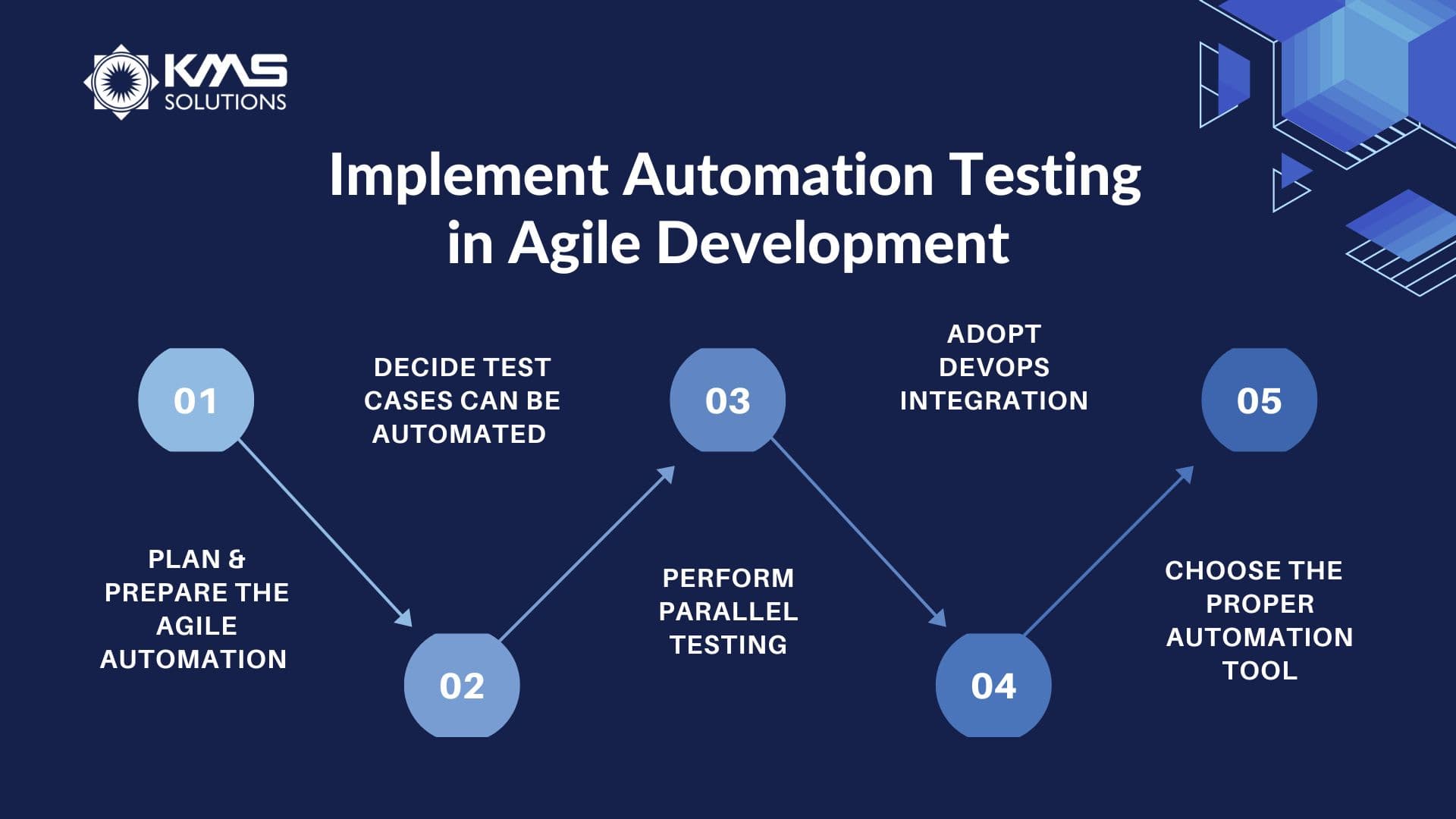Recently, the world has been witnessing the growth of Agile methodologies in building software and demands a new approach to testing.
John is a tester for an Agile development team working on a prevalent mobile banking application. This software is used by thousands of customers, and there are millions of transactions occur daily.
Since customer experience and data security are the main focus of the banking app, John has to work on new updates consistently to ensure a smooth and secure user journey. He also has to test the application whenever a new feature is added to guarantee that the new one won’t affect any of the existing features. As this entire operation needs to be accomplished in the short term, manual testing is not a suitable option in this widespread scenario.
Automation testing was not created to support Agile teams; nonetheless, it enables Agile testing – an essential part of the Agile concept to be achievable. This article will outline all the fundamentals of implementing automated testing for Agile teams.
What are the Differences between Test Automation in Agile vs. Waterfall?
1. Automation testing in Waterfall
Before the emergence of the Agile methodology, the software development team typically adopted the Waterfall model. This approach addressed development in a linear manner. Team members needed to work on phases, and each step must be completed before moving to the next one. This also means testing in this traditional approach can only be performed at the end of all design and development steps.
So, from the example in the introduction, John needs to finalize all the building works before testing it. In case bugs are defined, he will have to return to his code, examine every line in detail, investigate the errors, and rewrite the test cases for automation. This lengthy process will continue until the software is flawless. Moreover, even when the product is finally released, the slightest modification based on customers’ feedback requires the whole process to be repeated. Overall, this process will cause lots of time and may affect the product’s launching date.
2. Automation testing in Agile
In contrast, the Agile principle changes the games by making the process more flexible. While implementing this new methodology, the QA team can begin testing ahead of time and continue it throughout the process rather than waiting for the final development. Besides, accelerated product release needs testing done within a sprint. Thus, to speed up the testing process while ensuring flawless functioning, automation testing is worth considering.
By adopting this approach, John can create and test the product concurrently, ensuring all customer’s demands are adequately met and shortening the time-to-market, all in a lean way. With Agile’s automation testing, he can build various test scripts that will run automatically whenever there is a change to the software’s source code repository. This approach is called Continuous Testing in DevOps and makes sure that newly written code is error-free before hitting the production environment.
Test Automation Concepts when Implemented to Agile
| Test Automation Concepts | Agile Methodology Practices |
| The test must be repeated regularly | This is where the regression testing idea comes into play |
| The test’s process and its validation alter progressively over time | This doesn’t work well in Agile testing since Agile testing means frequent changes in requirements |
| The outcomes of test processes for a regulatory authority that requires findings to be routinely recorded and preserved as official proof of compliance | The exhaustive degree of documentation is incompatible with the Agile process |
| The test’s pass/fail results are reasonably easy to determine and capture with the selected automation tool | Suitable for those regression tests during Agile testing, which requires repetitive and laborious abilities |
| The test needs to drive a significant amount of data to the app | Can be incorporated as regression tests |
Why Should Agile Teams Embrace Automation Testing?
Today, over 71% of companies choose Agile as their preferred development approach due to its capability for continuous iteration. While manual testing in restricted timelines for the intricate, feature-rich product is almost impossible for the QA team, automation testing is best suited for faster testing outcomes in agile development.
Effortless regression testing
Agile methodology is designed to accommodate continuous changes. For each update, the software’s code-based must be tested to guarantee that they work correctly in light of any changes. Hence, it generates an enormous quantity of regression testing for QA teams to perform. Regression testing is the essential sort of testing to be automated. With all repetitive test cases prepared for automated execution, testers can relieve the burden of conducting them manually.
Faster test execution
As release velocity and the final product’s quality is the critical priorities of Agile, testing should be done parallel to development to guarantee all the defects identified are resolved at the earliest. Automated testing can help accelerate the testing practice since it allows test scripts to be once crafted and re-executed many times in various ways. Therefore, reusing test scripts can reduce a considerable amount of time for testing. Additionally, test script reusability can cut maintenance expenses significantly.
Optimal test coverage
Agile projects are often divided into one- to two-week sprints so that the team can finish their tasks. In such a short period, the testing team will need to spend intensive efforts to assure the quality of new releases and the functionality of all prior features. Through testing automation, the depth and scope of tests are expanded. This is because testers can develop a test suite for each feature of the product, such as data tables, internal programs, and memory contents.
By leveraging automation testing, you can execute complex test cases across different browsers and platforms, ensuring better and faster test coverage. At this time, manual testing needs are decreased, and testers can have time for other essential tasks.
Better communication and collaboration
The Agile approach is developed on a collaborative framework. With the involvement of the testing teams in every SDLC stage, swift communication is a prerequisite to keep up with constant updates. Moreover, automated testing tools give the team advanced reporting capabilities and integration with the CI/CD pipelines. These reports may ultimately play a significant role in the cycle.
Read more: Agile Testing & Its Application for Dedicated Software Development Team
How to Implement Automation Testing in Agile Development?

Despite the fact that test automation best performs on stable software, it can also fit into Agile if you know how to implement it appropriately. Here’re some fundamental points when it comes to designing a test automation strategy in Agile:
1. Plan and prepare the Agile automation beforehand
Agile is indicated to be a lean process that demands the team to complete all planned tasks within short sprints. To keep up with all the ever-changing requirements of customers, proactive communication between the testing and development teams is needed. This may only work if both teams are geared up for the initiative.
In addition to the automation testing strategy, all desired frameworks, along with the required tools, must be determined to be built properly before starting the project.
2. Decide test cases can be automated in Agile projects
Only some particular test cases in Agile projects are feasible for automation. With a vast number of requirement changes, Agile teams often make instantaneous modifications to the codebase, making it vulnerable and unstable. Such weak objectives are incompatible with test automation tools, which need costly script maintenance in the long run.
Regression testing, non-functional tests, API tests, and GUI tests are ideal for automation. In the midst of ever-changing demands, these tests are stable enough for the automation tool to execute well.
3. Perform parallel testing
Since the whole Agile development process concentrates on continuous delivery, parallel testing is best suited for this approach. With automation in place, the QA team can concurrently conduct numerous tests on different devices, browsers, and operating systems. This helps the testing team save a substantial amount of time, particularly in the final sprints of the project. In a broader perspective, team productivity and test quality are thus improved.
4. Adopt DevOps integration
DevOps refers to a set of practices that encourages cross-functional cooperation, which is a crucial aspect of Agile. It assists in bridging the gap between the development, QA and operations teams by allowing testers to report their testing process across teams seamlessly.
Besides, many automation tools have adopted DevOps integration as a standard. Testers may choose to integrate the tool into their CI/CD pipelines for a comprehensive solution.
5. Choose the appropriate automation tool
When selecting the automation tool, it’s crucial to consider one that can provide the maximum coverage possible. Moreover, it should be able for parallel testing, cross-browser testing, and minimal learning curve. Choosing the right testing tool can help you shorten the regression testing time and guarantee reliable, timely product releases.
With the nature of the Agile approach in mind, here are some criteria when choosing the automation tool that you should take into account:
- The tool should bring out positive ROI for your team in the long term.
- The tool can support a wide range of operating systems, devices, and browsers to execute parallel testing.
- The tool is suitable for the team members’ skills and experience.
- The tool’s learning curve should not be too steep so that all members of the QA team may rapidly become proficient with it.
Besides these criteria, the team also needs to consider other factors while choosing the appropriate automation tool for their projects.
Conclusion
The increasing demand for Agile implementations for the major software development teams highlights the competitive advantage of test automation. Although the benefits of automation cannot be determined until the long term, the testing team should have a plan for their automation strategies right at the beginning.
These five steps above are fundamental for all Agile practitioners to pay attention to when considering test automation. However, this is not a complete list. Depending on different cases, every team will need to examine other variables for their Agile automated testing strategy to reap the most advantages from the methodology.











